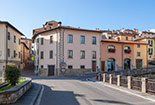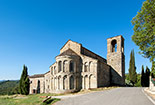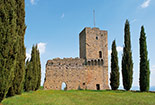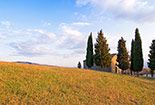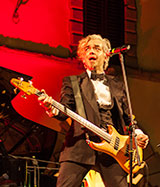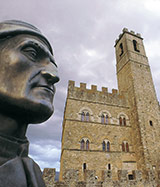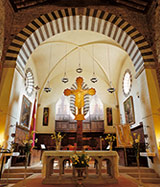PRATOVECCHIO
in Casentino, a Tuscan valley with which you can get familiar in every detail through this site
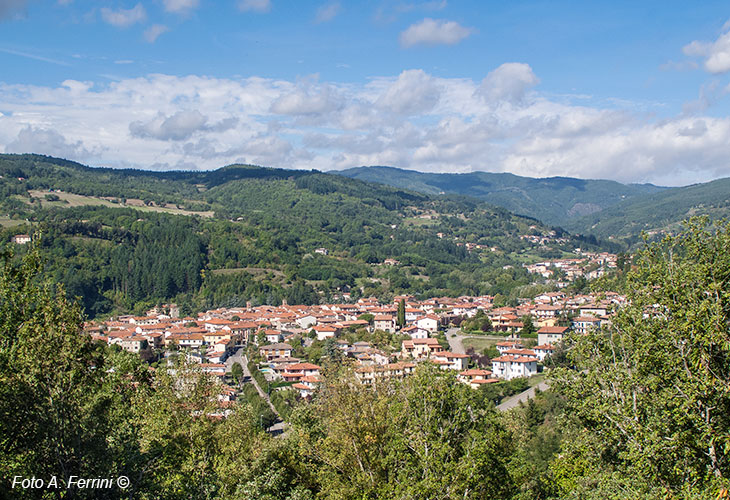
Texts and photos by Alessandro Ferrini ©
63 accurately described images of Pratovecchio. Click to enlarge
Pratovecchio, a castle on the plain in the Casentino valley
 Pratovecchio is located attached to the village of Stia. These two centers, located in the northernmost part of the Casentino and the first wet from the Arno, are part of the only municipality of Pratovecchio-Stia.
Pratovecchio is located attached to the village of Stia. These two centers, located in the northernmost part of the Casentino and the first wet from the Arno, are part of the only municipality of Pratovecchio-Stia.
Coming from the south, from Poppi and Bibbiena, Pratovecchio is announced by a tower on the top of a hill that we see before us. It is the Castle of Romena, one of the symbols of the Casentino. At the foot of this hill runs the Arno and beyond the river is the village.
On the Regional Road a detour to the left takes us towards the historic centre of Pratovecchio, but only a few hundred metres before a road to the right takes us to the nearby Abbey of Poppiena. Of this monastic place dating back to the eleventh century, today remains the church that is worth a visit for its simple elegance and for a beautiful Annunciation preserved here: a painting on wood by the Florentine painter Giovanni Da Ponte in the early decades of the fifteenth century. After visiting the church, we can head towards the old part of Pratovecchio.
 The origin of this upper Casentino village dates back to the 12th century, when Conti Guidi founded here their fortress with walls and towers, some of them still standing today. The fortified area is today the most historically and architecturally interesting part of Pratovecchio, Piazza Vecchia - actually dedicated to Jacopo Landino, a famous 14th century local painter, who worked mostly in Florence and Arezzo and who died in this village in 1358. The porches are a very important architectural feature in Piazza Vecchia. The porches also exist in both sides of the primary hamlet, via Garibaldi. In Piazza Landino there are also two of the most important historic buildings of the village: Palazzo Vigiani, headquarter of the Casentino Forests National Park and Palazzo Berti, which stands in front of the main church of Pratovecchio dedicated to SS. Nome di Gesù. The Church is worth a visit for the valuable pieces of art preserved here, which can be dated back to the 12th century. In a chapel on the right wall of the building,
The origin of this upper Casentino village dates back to the 12th century, when Conti Guidi founded here their fortress with walls and towers, some of them still standing today. The fortified area is today the most historically and architecturally interesting part of Pratovecchio, Piazza Vecchia - actually dedicated to Jacopo Landino, a famous 14th century local painter, who worked mostly in Florence and Arezzo and who died in this village in 1358. The porches are a very important architectural feature in Piazza Vecchia. The porches also exist in both sides of the primary hamlet, via Garibaldi. In Piazza Landino there are also two of the most important historic buildings of the village: Palazzo Vigiani, headquarter of the Casentino Forests National Park and Palazzo Berti, which stands in front of the main church of Pratovecchio dedicated to SS. Nome di Gesù. The Church is worth a visit for the valuable pieces of art preserved here, which can be dated back to the 12th century. In a chapel on the right wall of the building, there are three paintings on a golden background. The oldest one – and the most valuable as well – is a 13th century Madonna on the throne with the child by Maestro di Varlungo, probably a Cimabue’s pupil. The two other artworks are triptychs (one of them is missing the right part) both dated 14th century and attributed to Giovanni del Biondo. On the left side of the church, there is another valuable 1470 picture by Maestro di San Miniato portraying a Madonna with the child between Saints Maddalena, Giovanni Battista, Antonio Abate and Francis. On the walls of the church, there are other art pieces. The most valuable of them is the “Delivery of the keys to Saint Peter”, a 17th century oil on canvas by Jacopo Vignali, important painter in Florence, born in Pratovecchio. Along the right side of the church, there is a road that leads to the Monastery of the Camaldoli Nuns dedicated to San Giovanni Battista, built when Pratovecchio was founded. The rear walls of the monastery, in front of the Arno river, were also part of the walls of the old fortress. The church and the great 13th century still are worth vising.
there are three paintings on a golden background. The oldest one – and the most valuable as well – is a 13th century Madonna on the throne with the child by Maestro di Varlungo, probably a Cimabue’s pupil. The two other artworks are triptychs (one of them is missing the right part) both dated 14th century and attributed to Giovanni del Biondo. On the left side of the church, there is another valuable 1470 picture by Maestro di San Miniato portraying a Madonna with the child between Saints Maddalena, Giovanni Battista, Antonio Abate and Francis. On the walls of the church, there are other art pieces. The most valuable of them is the “Delivery of the keys to Saint Peter”, a 17th century oil on canvas by Jacopo Vignali, important painter in Florence, born in Pratovecchio. Along the right side of the church, there is a road that leads to the Monastery of the Camaldoli Nuns dedicated to San Giovanni Battista, built when Pratovecchio was founded. The rear walls of the monastery, in front of the Arno river, were also part of the walls of the old fortress. The church and the great 13th century still are worth vising.
Every two years in Pratovecchio there is a beautiful and engaging musical event: “Naturalmente Pianoforte”. During a weekend in July, in the most characteristic corners of the country are placed many pianos where musicians from far away perform non-stop from late afternoon to late at night. Every evening, then, in the beautiful setting of Piazza Vecchia concerts are held performed by prestigious piano performers.
A few minutes from Pratovecchio, you can find two important and fascinating mediaeval monuments, flagship for this village: the Romena castle and church. The first is a Romanesque church in the open countryside of indescribable beauty. Its apse, its capitals are authentic sculptures that show us so much medieval symbolism. To learn more about this church, which has been declared a National Monument, visit this section. The second, which we mentioned at the beginning of this text, is considered the first castle of Casentino already mentioned before the year one thousand. Today it is not more than a wreck, but it is possible to visit it and immerse in an extremely fascinating environment, both outside – with many secular cypresses along the path that leads to the castle –, and inside – with a great field, fenced by the remains of walls and towers. From the castle, a little road leads to the church. Fonte Branda – cited by Dante in his Divine Comedy – is located along the road. To explore the beauty of the Castle of Romena visit this section.



